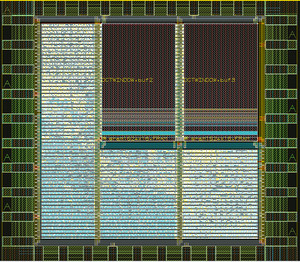
ufpe
Layout of the MP3…ufpeA research team comprising 4 professors and 23 undergraduate and graduate students from 3 Brazilian universities designed and successfully assembled 3 highly complex integrated circuits. These are widely used in the electronics world as key parts in various systems that equip multi media and digital TV. The chips comprise an 8051 processor, an MP3 decoder, and an MPEG4 decoder. The design of the integrated circuits followed international quality standards. Although these technologies are not new – Intel, for example, has built 8051 processors since the 1980’s – the work of this research team is very important because it helps train people to work at future chip manufacturing companies in Brazil. At the moment, only Freescale, a US company based in the city of Jaguariúna, in São Paulo State, develops equally complex chips in Brazil.
The more transistors an integrated circuit has, the more complex it is. The 8051 processor, for example, has 187 thousand transistors, while the MP3 decoder has 308 thousand and the MPEG4 has 430 thousand. “We managed to develop these circuits in partnership with the Federal University of Pernambuco (UFPE), the Electric Engineering Department of the Federal University of Campina Grande (UFCG) and the Computer Sciences Institute of the State University of Campinas (Unicamp),” says engineer Edna Barros, coordinator of the computer engineering course at the Information Technology Center of UFPE.
An important innovation in the work of the researchers is the implementation of circuits in modules that allow for bigger systems to be incorporated, including systems that can be integrated in a single chip. The team used modern design techniques, and thus was able to integrate the modules into a single chip. “This opens up a major possibility to add value to the modules and to enable their use in the development of more efficient, lower-cost and better-quality electronic products,” says the researcher from the Federal University of Pernambuco.
Integrated circuits nowadays are used in various kinds of consumer electronic equipment and in industrial automation all over the world. The MP3 decoder equips mobile telephones and most music players with the MP3 file format, while the MPEG4 decoder is widely used in cameras, video cameras and mobile telephones. An expanded version of this chip is part of every digital TV set manufactured in Brazil. The 8051 processor is one of the chips most widely used by manufacturers of industrial automation machines and equipment.

ufpe
…a circuit with the MPEG4…ufpeThe integrated circuits manufactured by the research team worked the first time they were tested. “The quality of the design and the level of the method employed are therefore confirmed. A 100% success rate for a first test run is crucial in the field of micro-electronics, because the cost – in financial terms as well as in terms of credibility and time – of an error is very high,” says Edna Barros.
The development of the three chips is part of the Brazil-IP project, funded by the Ministry of Science and Technology (MST) and run by the Information Technology Center of UFPE. The Brazil-IP project was begun in 2003 by Edna and professors Guido Araújo (Unicamp) and Elmar Melcher (UFCG). The objective of the program – which involves 16 universities – is to train human resources to design integrated circuits and to create a basis for the field of module design, so that professionals can work on other chips and qualify for intellectual property. The institutions that are part of the Brazil-IP program, currently budgeted at R$3 million, get equipment, software licenses and scholarship grants for undergraduate and graduate students. The funds are also allocated for the training of teachers and students and for exchange trips.

ufpe
… and the 8051ufpeUniversity license
Graduate students in electronic engineering, computer engineering and computer science courses are the target of the project headed by UFPE, Unicamp and UFCG. Although the chips were designed in Brazil, they were manufactured in Austria, because neither the research institutes involved in the project nor the companies based in Brazil had the necessary structure to produce the chips. According to Edna Barros, this situation is coming to an end, because, probably beginning in 2010, the country will finally have the infrastructure to manufacture this class of integrated circuits at the Center of Excellence in Advanced Electronic Technology (Ceitec), in the city of Porto Alegre, State of Rio Grande do Sul (see Pesquisa FAPESP nº 137); in late July, this center was renamed National Center of Advanced Electronic Technology (Ceitec S/A), a government-held company linked to the MST. “The design phase, however, is the main activity of chip development. On average, 60% of the price of the chip concerns its design,” says Edna, who also coordinates the Brazil-IP program. She explains that the integrated circuits were designed by using university licenses.
That is why they can only be used for academic purposes at Brazilian institutions. Initially planned to last for four years, the program began in 2003 and the chips were sent for manufacturing in May 2006. In the next two years, the professors and students involved in the research project implemented the circuits as chips. “Our next challenge is to pass this methodology on to professionals in this field and our experience has shown us that the earlier a student has contact with the field of micro electronics, the easier it is to arouse his or her interest in working in it and becoming a skilled professional.”
Republish
